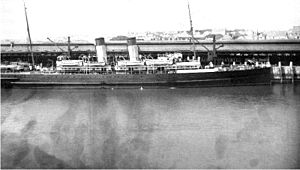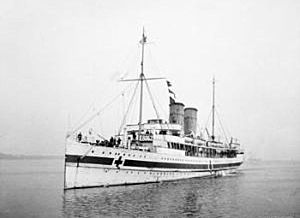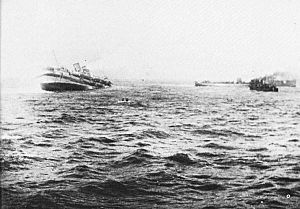HMHS Anglia facts for kids
SS Anglia was a special steamship that became a hospital ship during World War I. This means it carried injured soldiers and officers to safety. Sadly, on November 17, 1915, the Anglia hit a hidden naval mine that was placed by a German U-boat called UC-5.

SS Anglia, in 1905
|
|
Quick facts for kids History |
|
|---|---|
| Name | Anglia |
| Owner | London and North Western Railway |
| Route | Irish Sea ferry crossings |
| Builder | Wm Denny & Brothers, Dumbarton, Scotland |
| Yard number | 619 |
| Launched | 20 December 1899 |
| Completed | 10 April 1900 |
| Fate | Hit a mine laid by German U-boat UC-5 on 17 November 1915. |
| Notes | Sister ship of SS Hibernia (1899) |
| General characteristics | |
| Tonnage | 1,862 GRT |
| Length | 329 ft (100 m) |
| Beam | 39.1 ft (11.9 m) |
| Draught | 16 ft (4.9 m) |
| Propulsion |
|
| Speed | 21 knots (39 km/h) |
Contents
The Anglia's Story
The Anglia was built by a company called William Denny and Brothers in Dumbarton, Scotland. It was finished in the year 1900.
Early Journeys
At first, the Anglia worked as a ferry for the London and North Western Railway. It carried people across the Irish Sea. Its main routes were from Holyhead to Dublin North Wall. Later, it sailed from Holyhead to Kingstown, which is now called Dún Laoghaire.
Becoming a Hospital Ship
When World War I began, the Anglia was needed for a new job. It was turned into a hospital ship. This meant it would help transport injured soldiers and officers during the war.
The Sinking
On November 17, 1915, the Anglia was on its way back from Calais, France, to Dover, England. It was carrying 390 injured officers and soldiers.
Hitting a Mine
Around 12:30 in the afternoon, the Anglia hit a hidden mine. This happened about 1 nautical mile (about 1.85 kilometers) east of Folkestone Gate. The ship quickly began to sink and was gone in just fifteen minutes.
Rescue Efforts
A nearby warship, HMS Hazard, rushed to help. It worked to rescue the people on board. Another ship, a collier named Lusitania, also helped with the rescue.
Lives Lost and War Grave Status
Even with the help, 134 people died when the Anglia sank. Years later, in October 2014, people asked for the ship's wreck to be protected. They wanted it to be known as a war grave. This means it's a special place where those who died in war are honored.
In March 2017, the wreckage of the HMHS Anglia was officially declared a war grave. This makes it against the law to remove or disturb any human remains found at the site.



